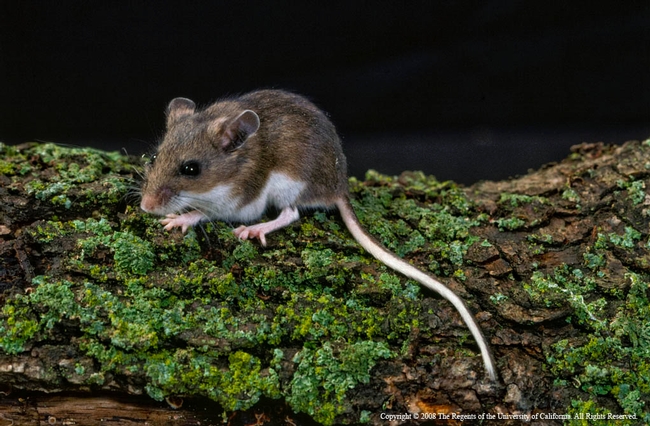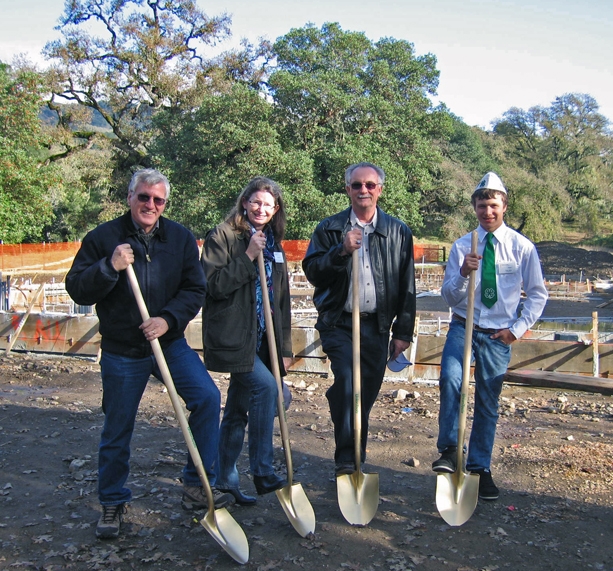Posts Tagged: Bob Timm
Recent cases of hantavirus a reminder to be mindful of deer mice
Two people in California were recently diagnosed with hantavirus infection, and one has died. Both of them spent time at Curry Village in Yosemite National Park, according to the California Department of Public Health. These new cases of hantavirus are a reminder to be aware of the threat and to take precautions to prevent infection.
Hantavirus is a very rare but very serious disease. About one-third of cases identified in California are fatal, CDPH reports. Since hantavirus was first identified in 1993, there have been 60 cases in California and 587 cases nationally. The two recent cases bring the total California case count for 2012 to four.
Hantaviruses are a group of viruses spread mainly by deer mice. The UC Integrated Pest Management Program recently published a comprehensive online Pest Note about deer mice, which details identification, biology and behavior, damage and management. The publication says deer mice are the most abundant and widely distributed mammal in North America. Proficient jumpers and runners, deer mice were so named for their agility.
Because deer mice prefer forests, grasslands and agricultural crops, they aren’t normally found in urban and residential areas unless fields, forests or other suitable habitats are close by. Deer mice shed the hantavirus in their saliva, urine and droppings. A person may be exposed to hantavirus by breathing contaminated dust after disturbing or cleaning rodent droppings or nests or by living or working in rodent-infested settings. There is no evidence that North American hantaviruses can spread from one person to another.
The most effective way to avoid contracting hantavirus from deer mice is to keep them out of houses, cabins, and dwellings by rodent-proofing and excluding them from these structures by sealing all small gaps and cracks. Once deer mice infest a dwelling, it is critical to avoid working and sleeping in these areas until the infestation has been controlled and the area has been made safe for humans.
Before occupying an infested building, open the doors and windows to air out the room for at least 30 minutes. Where possible, use an electric fan on windowsills and in door entrances to assist the process. Be sure to vacate the building during the ventilation process to prevent inhaling aerosolized particles. Wearing a commercially available cloth or paper breathing mask offers some protection and is better than no protection at all. However, only an approved respirator equipped with high-efficiency particulate air (HEPA) filters offers total respiratory protection against airborne viruses.
It is important to wear nonfabric gloves (e.g., rubber, latex, vinyl, or nitrile) when cleaning deer mouse-infested buildings. Because humans can contract the virus by inhaling aerosolized deer mouse urine and feces, never stir up dust by vacuuming or sweeping or through any other activity.
To disinfect potentially contaminated areas, thoroughly wet trapped deer mice, droppings, and nests with an appropriate disinfectant solution such as Lysol or a 10% hypochlorite (bleach) solution. To make this bleach solution, mix 1 1/2 cups of household bleach in 1 gallon of water (or one part bleach to nine parts water). Note that a bleach solution may damage rugs and fabrics and irritate skin. Wear nonfabric gloves whenever touching or cleaning contaminated surfaces or when handling mouse nests, dead mice, or mouse traps.
Once everything has soaked for 10 minutes, remove all nest material, mice and droppings with a damp towel and then mop or sponge the area with the disinfectant solution. Upholstered furniture and carpets can be shampooed and steam cleaned. If you wish to reuse the gloves used while cleaning contaminated areas, you must properly disinfect them before removal. After removing the gloves, it is important to thoroughly wash hands with soap and water or use a waterless alcohol-based hand sanitizer when soap is unavailable and hands aren’t visibly soiled.
The UC IPM Pest Note on deer mice was written by Niamh Quinn, Evolution, Ecology, and Behavior, University of Liverpool, Liverpool, U.K., niamh.quinn@liverpool.ac.uk; Roger Baldwin, UC Cooperative Extension advisor, Statewide IPM Program, Kearney Agricultural Research and Extension Center, Parlier; and Bob Timm, director, UC Hopland Research and Extension Center,. For additional up-to-date information on rodent cleanup, visit the Centers for Disease Control and Prevention Web site, http://www.cdc.gov/rodents/cleaning/index.html.
Hopland REC builds conference room
The article quotes Bob Timm, the center's director, as saying, "We want to talk to people about whether our vision meets what the needs in the community are -- we want a building that fits into Mendocino County." Timm hopes the building will help the center expand its community outreach programs by being a site for workshops, conferences and classes.
The $1.6 million project is funded by UC capital construction funds and private donations to the project.
Timm is encouraging gifts from the community so that that the facility including the added “Green Works” elements can be completed within the coming months. Descriptions of the building plans and added features are found on the Hopland REC website at http://ucanr.org/sites/hopland.
U.S. EPA, Napa County announce millions for water quality, flood damage, northern California salmon
An EPA press release announced nearly $3.3 million in federal, state and local funding aimed at restoring water quality and riparian and aquatic habitats in the Napa River watershed. As part of two major restoration efforts covering 15 miles of the Napa River, more than 40 landowners have committed to converting nearly 135 acres of farmland to wildlife habitat.
The primary grant recipient is Napa County, in partnership with the Napa County Resource Conservation District, the California Land Stewardship Institute, UC Cooperative Extension and the Rutherford Dust Restoration Team of the Rutherford Dust Society landowner group.
Woodpecker-ready siding to cover new conference center
Many people consider acorn woodpeckers' incessant rapping and acorn storage to be a nuisance. But the UC officials who are developing a new conference center at the UC Hopland Research and Extension Center in Mendocino County view the woodpeckers' activities as just another part of the natural system to incorporate into their plans.The University of California will break ground on the new 5,000-square-foot building this fall. In addition to providing meeting facilities for 200 and display space for a collection of natural and Native American museum pieces, the building itself will be a model of integrated green design, according to center director Bob Timm.
"This won't be a steel box with an air conditioner on the roof," Timm said. "We want a building that fits in the natural landscape, that is in itself teachable. We want a building people will talk about when they come to meetings here."
The architects' inspiration in designing the new conference center was old barns on the research center property that were built when it was still a commercial sheep ranch more than 60 years ago. The barns are riddled with woodpecker holes that the birds use over and over again.
To allow woodpeckers access to the new conference center without compromising the long-term integrity of the building, the facility will be protected with galvanized wire mesh then covered with cedar siding harvested from UC's own Blodgett Forest near Georgetown in the Sierra Nevada.
"This is just one of the ways we will be integrating the building into our rural landscape and making it look like Hopland," Timm said.
Blodgett Forest manager Rob York with cedar siding for the new conference center.





